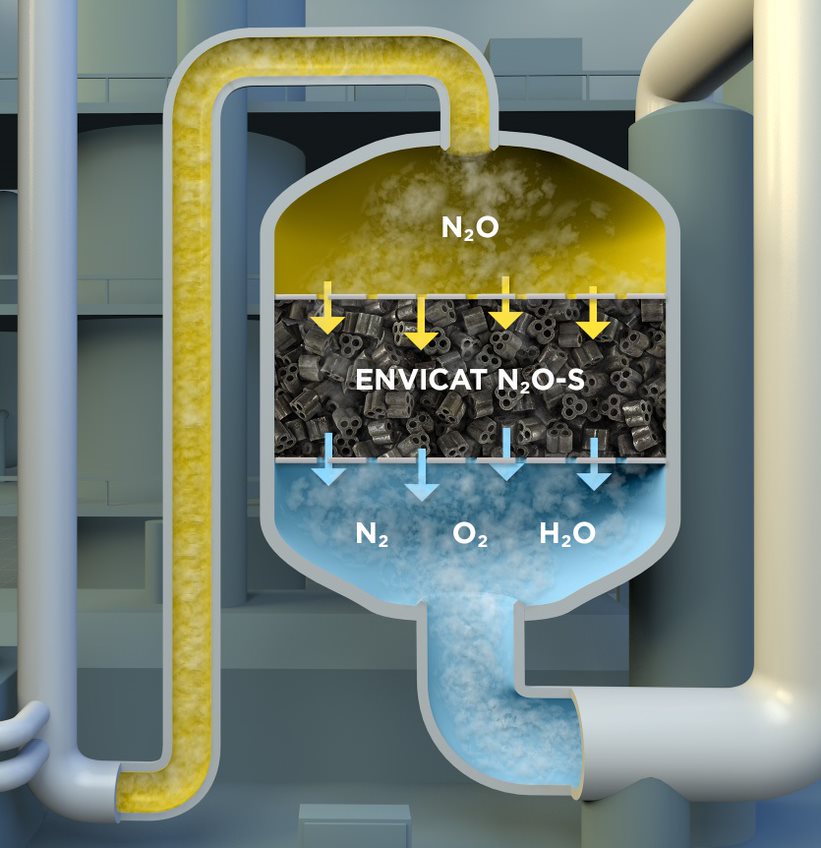Nitrous oxide – catching an elusive villain
In TV shows and movies, fictional villains – from Harry Potter’s Voldemort to Sherlock Holmes’ Prof. Moriarty – are often portrayed as mysterious creatures that live in the so-called dark side and have distinct physical characteristics. They may have a specific scar or smell as bad as their crime. Unlike these antagonists, nitrous oxide (N2O) is colorless and odorless. Yet, nitrous oxide is one of the most harmful greenhouse gases, whose human emissions rose 30% since 1980[1] and are causing a major impact on climate change. In the fight to protect the climate, Clariant has developed a catalyst that effectively cuts down nitrous oxide emissions and will give the opportunity to ten companies worldwide to try it for free.

Magic Mirror, on the wall, is nitrous oxide the biggest threat of all?
In the world’s effort to cut greenhouse gas emissions, most global focus has gone on evil sidekicks carbon dioxide (CO2), and methane (CH4). Nitrous oxide, the third-most-emitted greenhouse gas, also known as laughing gas, seems to go largely unnoticed. Yet molecule for molecule, nitrous oxide is about 300 times as potent as carbon dioxide at heating the atmosphere[1]. It is long-lived, spending an average of 114 years in the sky before disintegrating. It also depletes the ozone layer: when exposed to sunlight and oxygen, nitrous oxide converts into nitrogen oxides that damage the ozone layer, ultimately causing the biggest threat to the earth’s UV protection[2].With great power comes great responsibility
The largest source of nitrous oxide is agriculture, particularly in the use of fertilized soil[3]. The next-biggest contributor is the chemical industry, where nitrous oxide emissions stem from the production of nitric acid, an essential compound for making the kind of fertilizers that ensure reliable harvests for the world’s growing populations. Combined, however, these processes add the N2O-equivalent of about 100 million tons of CO2 into the atmosphere each year. To put that in perspective: There are only about 500 nitric acid plants worldwide. Their combined N2O emissions equal the carbon footprint of over 21 million cars[4].
The industry is well aware of the problem and is looking for ways to fix it. So are policymakers. For example, Germany’s Federal Ministry for the Environment launched the Nitric Acid Climate Action Group (NACAG). Its objective is "to incentivize the installation of effective N2O abatement technology in every nitric acid plant worldwide.”[5] That is good news, but even better: The solution is fairly easy and cheap to implement. It involves running exhaust gas from the nitric acid production through a bed of special catalysts rendering N2O harmless.

EnviCat™ N2O-S converts N2O formed during nitric acid production into harmless oxygen (O2) and nitrogen (N2).
There’s no hero without a villain
To combat climate change by enabling nitric acid companies to cut their nitrous oxide emissions, Clariant developed EnviCat™ N2O-S, its catalyst that can easily be ‘dropped’ in any nitric acid production factory, which is able to convert up to 95% of the nitrous oxide into harmless oxygen and nitrogen. The EnviCat™ N2O-S catalyst stays almost unaffected throughout the process and thus lasts for a long time. All this makes abating N2O emissions from nitric acid production relatively easy and cheap compared to other forms of greenhouse gas abatement. Cutting N2O in agriculture or transport, for example, can cost up to 100 times more per ton of CO2 equivalent. “It’s low-hanging fruit, something quite easy to manage, and should be done immediately,”[6]said Enrico Rubertus, Director of NACAG.
To date, Clariant’s N2O emission control catalysts are installed in more than 45 nitric acid production plants around the world. Combined, they reduce annual N2O emissions equivalent to more than 20 million metric tons of CO2. However, out of the approximate 500 nitric acid plants in operation, more than half still run without any N2O abatement at all. In the fight against climate change, the company recently launched its ‘Let’s Protect the Climate’ campaign, which offers first loads of their N2O-removal catalyst, EnviCat™ N2O-S, completely free to up to ten nitric acid producers worldwide. Any company that does not yet use an N2O abatement catalyst was able to apply until 31 March 2022.
Catalysts like EnviCat™ N2O-S provide a considerable contribution to environmental protection. And while they might not have superhero powers like Batman or Superman to fight against fictional villains, they help nitric acid producers worldwide to reduce their greenhouse gas emissions.
[1] Source: Haqin Tian et al., “A Comprehensive Quantification of Global Nitrous Oxide Sources and Sinks”, Nature, 7 Oct. 2020.
[2] Source: Josie Garthwaite, “Stanford expert explains why laughing gas is a growing climate problem”, Stanford News, 7 Oct. 2020.
[3] Source: Umweltbundesamt, “Nitrous oxide and methane”.
[4] Source: US EPA, “Greenhouse Gas Emissions from a Typical Passenger Vehicle”.
[5] Source: Nitricacidaction.org, “The Nitric Acid Climate Action Group”.
[6] Source: Chemical & Engineering News, "Nitrous oxide packs a dangerous climate punch, but much goes unabated".

